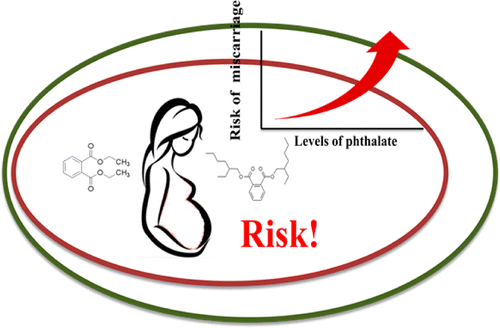Exposure to phthalates could be linked to pregnancy loss

A new study of more than 300 women suggests that exposure to certain phthalates—substances commonly used in food packaging, personal-care and other everyday products—could be associated with miscarriage, mostly between 5 and 13 weeks of pregnancy. The research, appearing in the ACS journal Environmental Science & Technology, is the first epidemiological study on non-work-related exposure to phthalates to provide evidence for the possible link among a general population.
Out of concern over the potential health effects of phthalates, the U.S. has banned six of these substances from use in certain products made for young children. But many are still included as ingredients in paints, medical tubes, vinyl flooring, soaps, shampoos and other items. Research on phthalates has shown that long-term exposure to low levels of the some of these compounds harms lab animals' health and can increase their risk for pregnancy loss. Additionally, at least one study found that female factory workers exposed to high levels of phthalates through their work were at a higher risk for miscarriage. But there is little epidemiological evidence of phthalates' effects on pregnancy among women with non-occupational exposure. Jianying Hu, Huan Shen and colleagues wanted to find out if there might be a link.
The researchers tested urine samples from 132 women who had miscarriages and 172 healthy pregnant women in China. They found pregnancy loss was associated with higher levels of urinary phthalate metabolites from diethyl phthalate (DEP), di-isobutyl phthalate (DiBP) and di-n-butyl phthalate (DnBP). Although this doesn't prove that phthalates cause pregnancy loss, the study suggests an association exists that the researchers say should be studied further.
More information: Levels of Phthalate Metabolites in Urine of Pregnant Women and Risk of Clinical Pregnancy Loss, Environ. Sci. Technol., 2015, 49 (17), pp 10651–10657. DOI: 10.1021/acs.est.5b02617
Abstract
Toxicological studies have shown that phthalate esters (PAEs), a class of widely used and environmentally prevalent chemicals, can increase the abortion rate in animals, but epidemiological evidence is scarce. This study aimed to explore the relationship between the urinary concentration of phthalate metabolites and the risk of clinical pregnancy loss. A total of 132 women who underwent clinical pregnancy loss (cases) and 172 healthy pregnant women (controls) were recruited from Beijing, China. Eight phthalate metabolites in urine were determined by ultraperformance liquid chromatography tandem mass spectrometry (UPLC–MS/MS). Five phthalate metabolites, monomethyl phthalate (MMP), monoethyl phthalate (MEP), monoisobutyl phthalate (MiBP), mono-n-butyl phthalate (MnBP), and mono(2-ethlyhexyl) phthalate (MEHP), were detected in at least 95% of the urine samples, with the highest median concentration of 51.0 μg/g of creatinine for MnBP of all participants. The differences in urinary concentrations of phthalate metabolites between cases and controls were evaluated using the Mann–Whitney U test. The concentrations of MEP (median of 18.7 μg/g of creatinine), MiBP (23.3 μg/g of creatinine), and MnBP (58.2 μg/g of creatinine) detected in the cases were significantly higher than those (15.7 μg/g of creatinine for MEP, 19.4 μg/g of creatinine for MiBP, and 43.9 μg/g of creatinine for MnBP) in the controls (p < 0.05). Increasing risks of clinical pregnancy loss were observed from the first to fourth quartiles of the MEP, MiBP, and MnBP concentrations (p < 0.05 for trend). We concluded that exposure to MEP, MiBP, and MnBP was associated with an increased risk of clinical pregnancy loss.













